The world’s polar bear population is set to plummet by 30% over the next 35 to 40 years due to climate warming, says the IUCN (International Union for Conservation of Nature) after re-assessing data on the Arctic Circle’s carnivorous bear.
Sea habitat loss, caused by global warming, is the single most important threat to the long-term survival of the polar bear (Ursus maritimus), according to the last update of The IUCN Red List of Threatened Species published today by IUCN.
The polar bear is among several life forms on Earth that face habitat loss and possible extinction. Several fungus species are likely to go, while over-fishing has been identified as the main cause of decline among marine bony fish.
 Polar bears will find it increasingly difficult to cope as the sea ice continues melting away.
Polar bears will find it increasingly difficult to cope as the sea ice continues melting away.
Thousands of species face extinction threat
Of the 79,837 assessed species in the IUCN Red List, 23,250 face a serious threat of extinction.
Scientists used the most recent sea ice and sub-population data to re-assess the status of the polar bear, as well as computer simulations and statistical models. Their aim was to predict future polar bear sub-populations due to reductions in sea ice.
They say, theirs is the most comprehensive assessment of this data so far. They calculated that there is a high likelihood that the worldwide polar bear population will plunge by over 30% by 2055. The polar bear is currently classed at ‘Vulnerable’ in the IUCN Red List.
Inger Andersen, IUCN Director General, said:
“Based on the latest, most robust science, this assessment provides evidence that climate change will continue to seriously threaten polar bear survival in the future.”
“Climate change impacts go far beyond this iconic species, and present a threat our planet has never faced before. Governments meeting at the climate summit in Paris later this month will need to go all out to strike a deal strong enough to confront this unprecedented challenge.”
 Polar bears rely on sea ice to access their prey.
Polar bears rely on sea ice to access their prey.
Sea ice melting away faster than we expected
According to studies, sea ice in the Arctic has been disappearing at a faster rate than most climate models had forecast. From 1979 to 2011, September sea ice shrank at a linear rate of 14% per decade.
Polar bears need sea ice to catch prey. If there is no sea ice for five or more consecutive months, the bears will have too spend to long fasting, which will likely lead to starvation in some areas, as well as reproductive failure.
By the end of this century, vast regions of the Canadian Arctic Archipelago will have no ice for over five months of the year, say recent sea ice projections. By 2050, other regions are forecast to reach the five-month ice-free threshold.
As the Arctic waters get warmer, prey species, such as ice seals, will be at higher risk of diseases, thus placing the polar bear at further risk.
Polar bears are vital for the livelihoods of local native human populations, and, as top of the food chain predators, they are crucial for maintaining ecosystem balance in the Arctic region.
Pollution and resource exploration another threat
Polar bears not only face sea ice loss, but also increased pollution, resource exploration and habitat change caused by development. For example, Arctic region oil development poses several serious threats, from spills to greater human-bear interaction.
Dag Vongraven, Chair of IUCN’s Species Survival Commission’s (SSC) Polar Bear Specialist Group, said:
“Whilst sea ice loss is the major threat to polar bears, the full range of current and potential threats must be considered in polar bear management plans.”
“It is encouraging that polar bear range states have recently agreed on a Circumpolar Action Plan – the first global conservation strategy to strive for the long-term persistence of polar bears in the wild. IUCN is actively working with those countries, providing scientific data and advice to help implement the agreed plan in the most efficient and cohesive way possible. We truly hope that the action plan will make a difference for polar bear conservation.”
More fungi facing greater threats
The number of fungi included in The IUCN Red List has now doubled to 29. Their main threats come from habitat loss and degradation, mostly from changing land use practices.
 Leptonia carnea’s survival status has deteriorated because of California’s more frequent and severe droughts and less fog.
Leptonia carnea’s survival status has deteriorated because of California’s more frequent and severe droughts and less fog.
The colourful blue Leptonia carnea, which is currently listed as Vulnerable, occurs just in the coastal redwood forest of California. More frequent droughts and less fog occurrence are affecting its habitat.
L. carnea is also threatened by continued logging of Sequoia sempervirens (redwood), which is listed as Endangered.
The survival of animals and plants is closely associated with the ecosystem services provided by fungi. They form a vital part of the digestive system of sheep, cows and other ruminants, and have a symbiotic relationship with most plants.
For humans fungi are an important source of food and components of several different medications. Penicillin, a widely-used antibiotic, as well as statins and other antibiotics, are fungal by origin. We also use fungi to make cheese, wine, beer, bread and many other foods.
Marine bony fishes
Many more marine bony fish species are at risk of extinction now in the Greater Caribbean and East Central Atlantic regions, the IUCN Red List update reveals. In the Caribbean, the invasive lionfish is under further pressure.
Three percent of the 1,400 marine bony fishes in the global assessment, which includes both deep-sea and nearshore fishes, covering the area from Angola to Mauritania, are today threatened with extinction.
 Due to over-exploitation, the roundhouse grenadier is today listed as Critically Endangered.
Due to over-exploitation, the roundhouse grenadier is today listed as Critically Endangered.
Due to over-exploitation, the roundnose grenadier (Coryphaenoides rupestris) is currently listed as Critically Endangered. Five percent of the 1,340 species assessed in the Caribben are threatened with extinction.
Being the largest group of fish, marine bony fishes are both economically and ecologically important. The livelihoods of over 340 million people would be seriously impacted if these species were lost, to say nothing of the threat to food security.
With the global human population predicted to double within the next 25 years, this new data will be used to help prioritize fisheries management and conservation decisions in the regions, including the identification of sites requiring the most urgent protection.
Kent Carpenter, Manager of IUCN’s Marine Biodiversity Unit, said:
“These assessments are the first of their kind, providing comprehensive baseline information within a specified region, which is critical for the designation and improved management of marine protected areas and threatened marine species.”
“The data should also lead to the development of more effective initiatives to improve national and regional fisheries management to maximise conservation benefits.”
Twenty-four newly assessed Critically Endangered species are probably now extinct, mainly due to habitat destruction and the threats from invasive species.
Many plants facing growing threat
Haha (Cyanea kolekoleensis), a species of flowering plant in the bellflower family that is native to the island of Kauai in Hawaiʻi, has been listed as Possibly Extinct. Several invasive plant species and pigs have threatened its habitat. There have been no Haha recorded sightings since 1998.
Eleven species of orchids found only in Madagascar are now listed as Critically Endangered/(Possibly Extinct).
The arico water frog (Telmatobius pefauri), which has not been seen since 1976, is listed as Critically Endangered/(Possibly Extinct). Cattle ranching and water extraction have been its main threats.
BBC Video – Hungry polar bear catches a seal
As the sea ice starts to break up in Summer, a female polar bear ingeniously uses the drift ice to sneak up on a seal.

